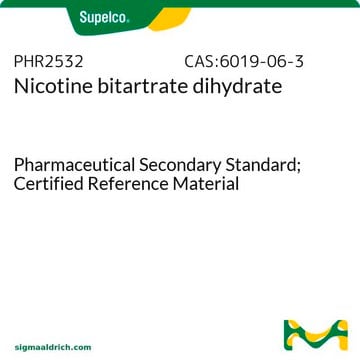SML1236
(−)-Nicotine hydrogen tartrate salt
≥98% (HPLC)
Synonyme(s) :
(−)-Nicotine ditartrate, (−)-1-Methyl-2-(3-pyridyl)pyrrolidine (+)-bitartrate salt
About This Item
Produits recommandés
Niveau de qualité
Pureté
≥98% (HPLC)
Forme
powder
Activité optique
[α]/D +20 to +26°, c = 1.0 in water
Conditions de stockage
desiccated
Couleur
white to beige
Solubilité
H2O: 20 mg/mL, clear
Température de stockage
room temp
Chaîne SMILES
CN1CCC[C@H]1C2=CC=CN=C2.C
InChI
1S/C10H14N2.CH4/c1-12-7-3-5-10(12)9-4-2-6-11-8-9;/h2,4,6,8,10H,3,5,7H2,1H3;1H4/t10-;/m0./s1
Clé InChI
RYYKFQGHMYGLEL-PPHPATTJSA-N
Vous recherchez des produits similaires ? Visite Guide de comparaison des produits
Application
Actions biochimiques/physiologiques
Mention d'avertissement
Danger
Mentions de danger
Conseils de prudence
Classification des risques
Acute Tox. 2 Inhalation - Acute Tox. 3 Oral - Aquatic Chronic 2 - Eye Irrit. 2 - Repr. 2
Code de la classe de stockage
6.1A - Combustible acute toxic Cat. 1 and 2 / very toxic hazardous materials
Classe de danger pour l'eau (WGK)
WGK 2
Point d'éclair (°F)
289.8 °F
Point d'éclair (°C)
143.2 °C
Certificats d'analyse (COA)
Recherchez un Certificats d'analyse (COA) en saisissant le numéro de lot du produit. Les numéros de lot figurent sur l'étiquette du produit après les mots "Lot" ou "Batch".
Déjà en possession de ce produit ?
Retrouvez la documentation relative aux produits que vous avez récemment achetés dans la Bibliothèque de documents.
Les clients ont également consulté
Notre équipe de scientifiques dispose d'une expérience dans tous les secteurs de la recherche, notamment en sciences de la vie, science des matériaux, synthèse chimique, chromatographie, analyse et dans de nombreux autres domaines..
Contacter notre Service technique











